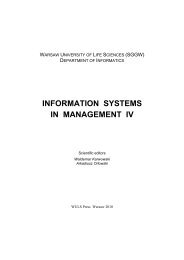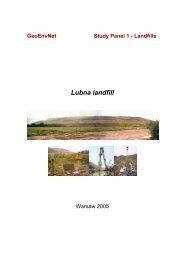ACTA SCIENTIARUM POLONORUM - SGGW
ACTA SCIENTIARUM POLONORUM - SGGW
ACTA SCIENTIARUM POLONORUM - SGGW
You also want an ePaper? Increase the reach of your titles
YUMPU automatically turns print PDFs into web optimized ePapers that Google loves.
Changes in rural women’s movement related to Poland’s accession... 163Rural women are also active in local organizations aims of which are not directly relatedto subject matter and women’s movement. They join the activity of such organizationsas voluntary fire brigades, rural sports clubs, church organizations, youth organizationsas well as parents’ councils functioning near schools. The village councils also constitutesignificant part of civic life [Kamiński 2009]. In connection with the Poland’s accessionto the European Union the new social organizations are being established in the ruralareas. They belong to a non-governmental organizations sector. Acting as associations orfoundations, these organizations run schools, propagate natural and cultural heritage ofthe region they inhabit. These communities try to adapt to changing living conditions inthe country through such an activity [Kamiński 2009]. According to R. Śpiewak, apartfrom the accession of Poland to the EU, the development of civic society constitutes theadditional factor which supports the growth of non-governmental organizations in thecountry [Śpiewak 2008].M. Halamska’s opinion is that the organizations mentioned above can be characterizedby the following features: “focused to the center, without base or support in the area.She thinks that it is difficult to describe them as fully civic organizations: “… in the socialreality they have all the features of “appearance” and “façade” which are legitimized bythe law and state subsidies” [Halamska 2008]. During the interviews with rural activistsI became convinced that one of main incentives for establishment of their associations orfor transformation was the possibility to take advantage of various ways in which theiractivity can be financed. As far as I am concerned, the money constitutes for them ratheran instrument which enables them to achieve the goals they set, not an aim in itself.R. Kamiński is of the opinion that “there is no point in dividing them [i.e. organizations]into “better”, “worse”, “old” and “new”. There are the inhabitants who verifyhow they functioning” [Kamiński 2009]. Changes in the rural women’s activity in theirorganizations may be analyzed with reference to their membership in the local activitygroups (LAG) which are responsible for implementation of local development strategiesprepared within the scope of the Leader approach. This initiative has been implementedin Poland since 2004 (EU budget programming period 2000–2006). Seventy out of 150existing groups were analyzed in terms of the membership in LAG. It turned out that only10 typical women’s organizations, including first of all village women’s clubs, belongedto the local groups [Śpiewak 2009]. A similar analysis was conducted in 2009. Therewere 110 LAG taken into account, which constituted 30% of all LAG existing currentlyin Poland and chosen to implement the local strategies for the period 2007–2013 they prepared.It was reported that women’s organizations were involved into 22 LAG [Ściański,Żak 2009]. The increase of women’s involvement in the activity for local communitiescan be noticed while comparing both programming periods.Being active, women count on the support of local government authorities. The relationsbetween local government authorities and organizations are of a different character.Sometimes these organizations may count on support in the form of grants for atrip or an event organization [Desperat 2008]. However, there are also other situations.This cooperation does not only concern the implementations of projects requiring financialresources, but also consists in planning, information exchange, negotiating variousundertakings and participation in committees [Śpiewak 2008]. I asked my intervieweesabout the cooperation with local government authorities. Each of them emphasized, thatsuch a cooperation played a very significant role in functioning of the associations theyOeconomia 10 (1) 2011
















